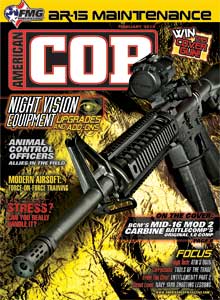First, let me say I enjoy reading your magazine. As a retired canine officer of 27 years (17 of those working a police dog) and a total of 43 years training police dogs, I must point out some major faults with the article about canine deployment (“Worth The Wait? K9 Deployment Savvy,” October 2013).
The picture depicting an officer walking his dog on lead indicates a control problem with his dog; he probably hasn’t received proper training in leash control and obedience. If the dog is working on the street, he shouldn’t even be on lead unless policy prohibits such activity.
The statement, “The handler will have their hands full with the dog, so cuffing a suspect is usually out of the question for them,” is only true if the canine team hasn’t had proper training. The handler should be able to down the dog and cuff the suspect without the dog breaking the down stay. Officers I train don’t use leads on the street, including skids deployments.
Lastly, “Dogs don’t pick up on a fear scent…” Totally untrue! They can discriminate a “fear scent” from others who are not afraid of being caught by the police. A discriminating police dog will weave through a group of officers and bite a suspect they’re fighting. Granted, some dogs will bite anything in their path including officers, children or any other moving object, but these dogs should be avoided for police use.
K9’s are force multipliers and are a tremendous tool for law enforcement when properly trained. When budgets are slim, more police dogs should be deployed, not less. The man hours saved searching for suspects, evidence, explosives and narcotics makes them invaluable.
Steve Brewer, CEO
Law Dogs, Inc.
As the saying goes, “There’s more than one way to skin a cat.” I’m sure your way of training is different than other methods, but it doesn’t make one better than the other — just different. One picture is not sufficient information to make a sweeping comment about what may or may not be a problem with training; it’s simply a picture. A K9 officer may have to cuff a suspect on his own, but most times there are plenty of other officers around to handle it, so why risk an unnecessary bite (of suspect or officer)? Whether dogs can pick up on a fear scent, it’s debatable. Scientists and animal behaviorist continue to haggle over the issue, and I’d hazard a guess what dogs’ sense is more likely a combination of smells and visual clues. SH
Order Your Printed Copy Of The American COP February 2014 Issue Today!
Download A PDF Of The American COP February 2014 Issue Now!











